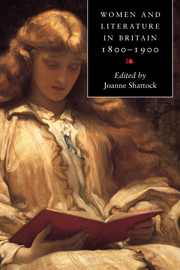Book contents
- Frontmatter
- Contents
- List of contributors
- Acknowledgments
- Chronology
- Introduction
- 1 The construction of the woman writer
- 2 Remaking the canon
- 3 Women and the consumption of print
- 4 Women writing woman: nineteenth-century representations of gender and sexuality
- 5 Feminism, journalism and public debate
- 6 Women's writing and the domestic sphere
- 7 Women, fiction and the marketplace
- 8 Women poets and the challenge of genre
- 9 Women and the theatre
- 10 Women writers and self-writing
- 11 The professionalization of women's writing: extending the canon
- 12 Women writers and religion
- 13 Women writing for children
- Guide to further reading
- Index
3 - Women and the consumption of print
Published online by Cambridge University Press: 03 October 2009
- Frontmatter
- Contents
- List of contributors
- Acknowledgments
- Chronology
- Introduction
- 1 The construction of the woman writer
- 2 Remaking the canon
- 3 Women and the consumption of print
- 4 Women writing woman: nineteenth-century representations of gender and sexuality
- 5 Feminism, journalism and public debate
- 6 Women's writing and the domestic sphere
- 7 Women, fiction and the marketplace
- 8 Women poets and the challenge of genre
- 9 Women and the theatre
- 10 Women writers and self-writing
- 11 The professionalization of women's writing: extending the canon
- 12 Women writers and religion
- 13 Women writing for children
- Guide to further reading
- Index
Summary
Charlotte Brontë's Jane Eyre, published in the middle of the nineteenth century (1847), opens with a scene in which the child Jane has retreated into ‘a double retirement’; a window seat with drawn curtains provides a safe physical space, the book she holds on her crossed knees provides a psychological space distinct from, though resonating with, the harsh reality of her situation. In this opening scene, reading gives the female child pleasure and also provides a way of understanding herself and her place in the world. Called from her book by the bullying John Reed, she names him a tyrant ‘like the Roman slave drivers’ she has read about in Goldsmith's History of Rome. It is no wonder that John Reed forbids her the book and reminds her that it is his property, since he is the man of the house. From this moment to the end of the novel, in which Jane reads the world and books to the blind Rochester, Jane Eyre implicitly invokes other experiences of reading and explicitly invites ‘The Reader’ into the text.
This moment from Jane Eyre suggests some of the themes I want to address in considering the topic of nineteenth-century women as consumers of print. These include questions of access to print; print as property – in other words its circulation in the form of commodities in the most advanced capitalist economy of the nineteenth century; reading in relation to physical and psychological space, for – as this passage emphasizes – books are both material objects and texts to be read; reading as a source of pleasure for women and a way of making sense of themselves and the world; its potential power, and the anxieties which reading (especially the reading of young women) produced in those with authority over them.
- Type
- Chapter
- Information
- Women and Literature in Britain 1800–1900 , pp. 55 - 77Publisher: Cambridge University PressPrint publication year: 2001
- 3
- Cited by

